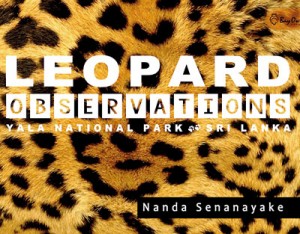Sunday Times 2
A labour of love on leopards
View(s):I have read all the articles pertaining to leopards in Loris, the journal of the Wildlife & Nature Protection Society. This covers a period of over 75 years from 1936 up to now. All these articles deal with shooting leopards in various parts of the island. Roper Agar is one of the few who records the behaviour of a leopard in his account of shooting the ‘Man-eater of Punani’. That too is in respect of one leopard.
Leopard Observations written by Nanda is very timely and welcome in that it records his observations of leopards in the Yala National Park during his many visits over a period of seven years and nine months. Yala has one of the world’s most dense leopard populations.
Nanda has kept meticulous records of all his observations of the leopards in Yala during this period. The detailed information he has gathered has been carefully analysed and converted to useful information. This information would be invaluable to anyone wanting to study leopards in the future.
Nanda Senanayake was an outstanding cricketer, tennis and hockey player during his school days at Royal College, Colombo. However he did not pursue these sports on leaving school. His love for the wild lured him to the jungles and away from playing fields. Nanda was a regular visitor to our national parks and other wilderness areas. These visits were not confined to pleasure trips but he also used them as a continuous opportunity to study of our rich natural world.
Nanda is an expert on the island’s bird life having gone to all parts of the island to pursue his interest in ornithology over a long period of time. He was in the first group to photograph the Serendib Scops Owl (Otus thilohoffmani) in Sinharaja after the initial sighting by Deepal Warakagoda. Nanda carried out an extensive study to classify birds according the size of their eggs. However he is reluctant to publish it for reasons best known to him. Many who have seen the manuscript have urged him to publish.
There are four species of the cat family in Sri Lanka. They are the Jungle Cat (Felis chaus kelaarti), the Rusty-spotted Cat (Prionailurus rubiginosus), the Fishing Cat (Prionailurus viverrinus) and the Sri Lankan leopard (Panthera pardus kotiya), which is the largest of our cats.
The leopard belongs to the family Felidae and is one of the most widespread mammals. Leopards are found throughout most of Africa and Asia from the Middle East to the Soviet Union, Korea, China, India, and Malaysia. Leopards live in a variety of habitats including forests, mountains, grassland and deserts. They can easily adapt to a new habitat. However if the habitat does not have a sufficient supply of small mammals for them to feed on they are not averse to taking domestic dogs, goats and even young calves.
There are nine subspecies of leopard in the world. They are the Amur leopard, the Indian leopard, the Anatolian leopard, the Javan leopard, the Persian leopard, the Snow leopard, the Clouded leopard, the Arabian leopard and the Sri Lankan leopard. Each of these sub species vary in size, background colour, markings on the body, thickness and length of fur and the habitats they occupy.
Nanda writes that in December 2004, whilst visiting Yala National Park, he observed a lone male one evening and a little later he observed a female with two cubs. Early next morning he observed another female with three cubs. The sightings of eight different leopards within four kilometres of road in less than 24 hours encouraged Nanda to keep a detailed record of his observations on his regular visits to Yala in the next seven years and nine months. The results are in this book.
The results of the studies on the leopard carried out by the late Dr. Ravi Samarasinha, the late Harith Perera, Dr. Sriyanie Miththapala, who reclassified the panthera species, Jehan Kumara, Rukshan Jayewardene and Andrew Kittle together with Nanda’s study, becomes important references for researchers, students and the amateur leopard enthusiast.
Nanda Senanayake has to be congratulated for his labour of love and I am sure his efforts will give pleasure to many and be of use to serious students of our leopards. This is a book that all those interested in leopards should have.
Available exclusively from the author from -November 27 until December 31, 2014, at a 10% discount (Rs. 2250): 174/3 Inner Flower Rd., Colombo 3
(Tel: 0-777-718-045). Also available online from
www.pererahussein.com
Book Facts
Leopard Observations – Yala National Park, Sri Lanka. by Nanda Senanayake
Price: Rs. 2500
Reviewed by Jayantha Jayewardene

